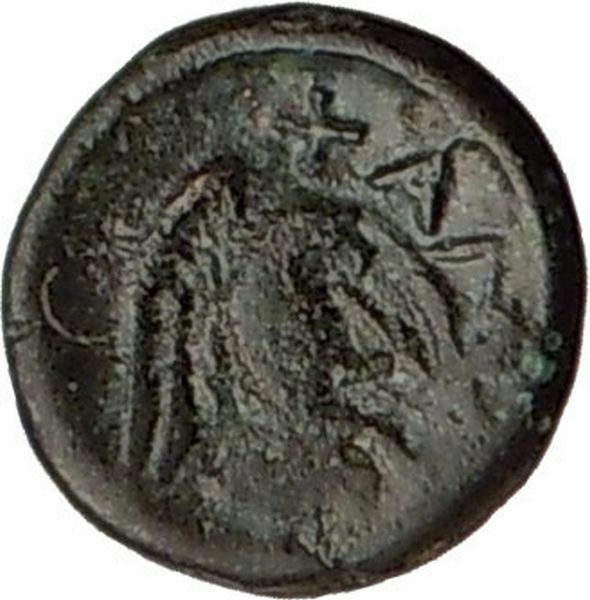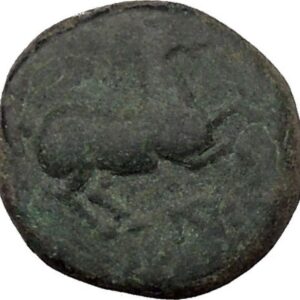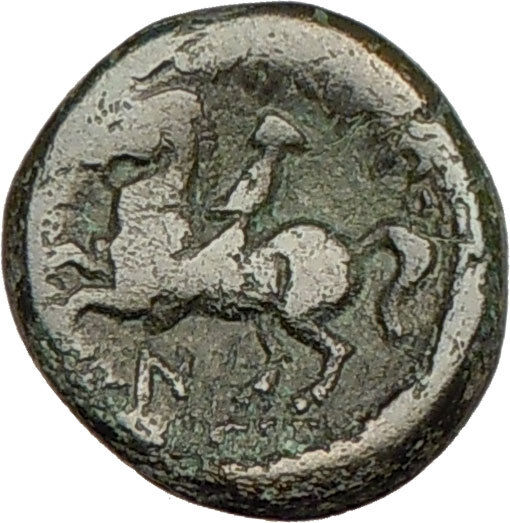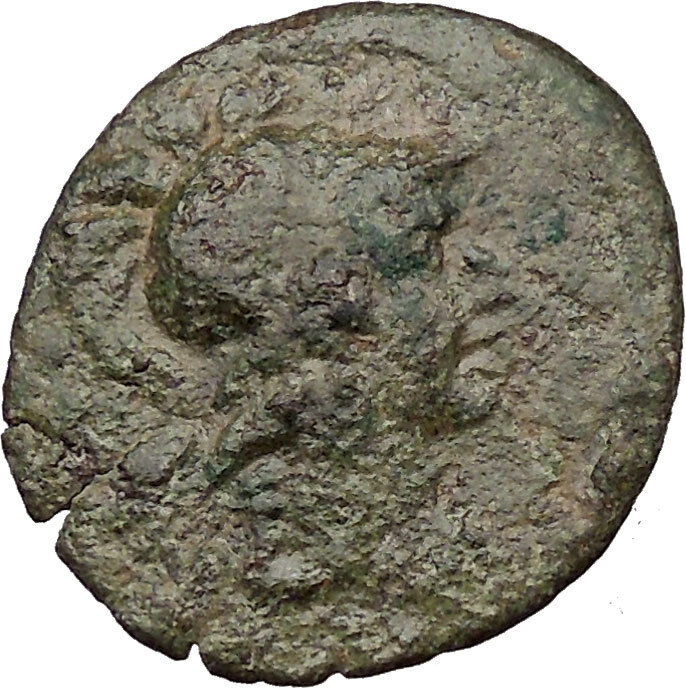|
Greek city of Thessalonica in Macedonia
Bronze 19mm (5.65 grams) from the ancient Greek city of Thessalonica in
the Province of Macedonia 88-21 B.C. under the control of the Romans
Reference: Moushmov 6607
Laureate head of Janus
ΘEΣΣAΛONIKEΩN, Two Centaurs prancing, back to back, each holding branch.
You are bidding on the exact item pictured,
provided with a Certificate of Authenticity and Lifetime Guarantee of
Authenticity.
In Roman mythology,
Janus is the god of gates,
doors, doorways, beginnings, endings and time. Most often he is depicted as
having two heads, facing opposite directions; one head looks back at the last
year while the other looks forward to the new, simultaneously into the future
and the past.
Janus was usually depicted with two heads facing in opposite directions.
According to a legend, he had received the gift to see both future and past from
the god
Saturn
in reward for the hospitality received.
Janus-like heads of gods related to
Hermes
have been found in Greece, perhaps
suggesting a compound god.
The Romans associated Janus with the
Etruscan deity
Ani
. Several scholars suggest that he was
likely the most important god in the Roman archaic pantheon. He was often
invoked together with Iuppiter (Jupiter).
According to
Macrobius
and
Cicero
, Janus and Jana (Diana)
are a pair of divinities, worshipped as the
sun
and
moon
, whence they were regarded as the highest
of the gods, and received their sacrifices before all the others.
In general, Janus was the patron of concrete and abstract beginnings of the
world (such as the religion and the gods themselves), the human life, new
historical ages, and economical enterprises. He was also the god of the home
entrance (ianua), gates, bridges and covered and arcaded passages (iani)
named after him.
He was frequently used to symbolize change and transitions such as the
progression of past to future, of one condition to another, of one vision to
another, the growing up of young people, and of one universe to another. He was
also known as the figure representing time because he could see into the past
with one face and into the future with the other. Hence, Janus was worshipped at
the beginnings of the harvest and planting times, as well as marriages, deaths
and other beginnings. He was representative of the middle ground between
barbarity and civilization, rural country and urban cities, and youth and
adulthood.
Numa
in his regulation of the
Roman calendar
called the first month
Januarius
after Janus, at the time the
highest divinity. Numa also introduced the
Ianus geminus
(also Janus Bifrons,
Janus Quirinus or Portae Belli) , a passage ritually opened at
times of war, and shut again when Roman arms rested. It formed a walled
enclosure with gates at each end, situated in the
Roman Forum
which had been consecrated by
Numa Pompilius
. In the course of wars, the
gates of the Janus were opened, and in its interior sacrifices and vaticinia
were held to forecast the outcome of military deeds. The doors were closed only
during peacetime, an extremely rare event.
Livy wrote in his
Ab urbe condita
that the doors of the
temple had only been closed twice since the reign of Numa: firstly in 235 BC
after the
first Punic war
and secondly in after the
battle of Actium
in 31 BC. A temple of Janus is
said to have been consecrated by the consul
Gaius Duilius
in 260 BCE after the
Battle of Mylae
in the Forum Holitorium. The
four-side structure known as the
Arch of Janus
in the
Forum Boarium
dates to the 4th century CE.
In the Middle Ages, Janus was also taken as the symbol of
Genoa
, whose Latin name was Ianua, as
well as of other European communes.
In
Greek mythology
, a centaur (from
Ancient Greek
:
Κένταυροι – Kéntauroi) or hippocentaur is a member
of a composite race of creatures, part
human
and part
horse
. In early
Attic
and
Boeotian
vase-paintings
(see
below
), they are depicted with the hindquarters
of a horse attached to them; in later renderings centaurs are given the torso of
a human joined at the waist to the horse’s
withers
, where the horse’s neck would be.
This half-human and half-animal composition has led many writers to treat
them as
liminal beings
, caught between the two natures,
embodied in contrasted myths, both as the embodiment of untamed nature, as in
their battle with the
Lapiths
, or conversely as teachers, like
Chiron
.
The centaurs were usually said to have been born of
Ixion
and
Nephele
(the cloud made in the image of
Hera). Another version, however, makes them children of a certain
Centaurus
, who mated with the
Magnesian
mares. This Centaurus was either
himself the son of Ixion and Nephele (inserting an additional generation) or of
Apollo
and
Stilbe
, daughter of the river god
Peneus
. In the later version of the story his
twin brother was
Lapithus
, ancestor of the
Lapiths
, thus making the two warring peoples
cousins.
Centaurs were said to have inhabited the region of Magnesia and Mount
Pelion
in
Thessaly
, the
Foloi oak forest
in
Elis, and the Malean peninsula in southern
Laconia
.
Centaurs continued to figure in literary forms of
Roman mythology
. A pair of them draw the
chariot of
Constantine the Great
and his family in the
Great Cameo of Constantine
(c314-16),
which embodies wholly pagan imagery.
The city Thessalonica in Macedonia
was founded around
315 BC
by the
King
Cassander of Macedon
, on or near the site of the ancient town of
Therma
and
twenty-six other local villages. He named it after his wife
Thessalonike
, a half-sister of
Alexander the Great
. She gained her name (“victory of Thessalians”: Gk
nikē
“victory”) from her father,
Philip II
, to commemorate her birth on the day of his gaining a victory over
the
Phocians
, who were defeated with the help of
Thessalian
horsemen, the best in Greece at that time. Thessaloniki developed
rapidly and as early as the
2nd
century BC
the first walls were built, forming a large square. It was an
autonomous part of the Kingdom of
Macedon
, with its own parliament where the King was represented and could
interfere in the city’s domestic affairs.
Roman
era
After the fall of the kingdom of Macedon in
168 BC
,
Thessalonica became a city of the
Roman Republic
. It grew to be an important trade-hub located on the
Via
Egnatia
, the
Roman road
connecting
Byzantium
(later
Constantinople
), with
Dyrrhachium
(now Durrës
in
Albania
), and
facilitating trade between Europe and Asia. The city became the capital of one
of the four Roman districts of Macedonia; it kept its privileges but was ruled
by a praetor
and had a Roman garrison, while for a short time in the
1st
century BC
, all the Greek provinces came under Thessalonica (the Latin form
of the name). Due to the city’s key commercial importance, a spacious harbour
was built by the Romans, the famous Burrowed Harbour (Σκαπτός Λιμήν) that
accommodated the town’s trade up to the eighteenth century; later, with the help
of silt deposits from the river
Axios
, it was
reclaimed as land and the port built beyond it. Remnants of the old harbour’s
docks can be found in the present day under Odos Frangon Street, near the
Catholic Church.
Thessaloniki’s
acropolis
,
located in the northern hills, was built in
55 BC
after
Thracian
raids in the city’s outskirts, for security reasons.
The city had a
Jewish
colony, established during the
first
century
, and was to be an early centre of
Christianity
. On his second missionary journey,
Paul
of Tarsus
, born a Hellenized Israelite, preached in the city’s synagogue,
the chief synagogue of the Jews in that part of Thessaloniki, and laid the
foundations of a church. Other Jews opposed to Paul drove him from the city, and
he fled to
Veroia
. Paul wrote two of his
epistles
to the Christian community at Thessalonica, the
First Epistle to the Thessalonians
and the
Second Epistle to the Thessalonians
.
Thessaloníki acquired a patron saint,
St. Demetrius
, in 306. He is credited with a number of miracles that saved
the city, and was the Roman
Proconsul
of Greece under the anti-Christian emperor
Maximian
,
later martyred at a Roman prison where today lies the
Church of St. Demetrius
, first built by the Roman sub-prefect of
Illyricum
Leontios in 463. Other important remains from this period include
the
Arch and Tomb of Galerius
, located near the centre of the modern city.
|









